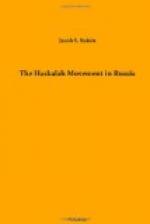Still more interesting and, for our purpose, more important were their public and private institutions of learning. Jews have always been noted for the solicitous care they exercise in the education of the young. The Slavonic Jews surpassed their brethren of other countries in this respect. At times they wrenched the tender bond of parental love in their ardor for knowledge. With a republican form of government they created an aristocracy, not of wealth or of blood, but of intellect. The education of girls was, indeed, neglected. To be able to read her prayers in Hebrew and to write Yiddish was all that was expected of a mother in Israel. It was otherwise with the boys. Every Jew deemed himself in duty bound to educate his son. “Learning is the best merchandise”—Torah iz die beste sehorah—was the lesson inculcated from cradle to manhood, the precept followed from manhood to old age. All the lullabies transmitted to us from earliest times indicate the pursuit of knowledge as the highest ambition cherished by mothers for their sons:
Patsche, patsche, little tootsies,
We shall buy us little bootsies;
Little bootsies we shall buy,
To run to heder we shall try;
Torah we’ll learn and all good ma’alot
(qualities),
On our wedding eve we shall solve sha’alot
(ritual problems).[39]
To have a scholarly son or son-in-law was the best passport to the highest circles, a means of rising from the lowliest to the loftiest station in life.
It is no wonder, then, that schools abounded in every community. At the early age of four the child was usually sent to the heder (school; literally, room), where he studied until he was ready for the yeshibah, the higher “seat” of learning. The melammedim, teachers, were graded according to their ability, and the school year consisted of two terms, zemannim, from the first Sabbath after the Holy Days to Passover and from after Passover to Rosh ha-Shanah. The boy’s intellectual capacities were steadily, if not systematically, cultivated, sometimes at the expense of his bodily development. It was not unusual for a child of seven or eight to handle a difficult problem in the Talmud, a precocity characteristic to this day of the children hailing from Slavonic countries. Their ’illuyim (prodigies) might furnish ample material for more than one volume of les enfants celebres.
Nor were the children of the poor left to grow up in ignorance. Learning was free, to be had for the asking. More than this, stringent measures were taken that no child be without instruction. Talmud Torahs were founded even in the smallest kehillot (communities), and the students were supplied, not only with books, but also with the necessaries of life. Communal and individual benefactors furnished clothes, and every member (ba’al ha-bayit) had to provide food and lodging for an indigent pupil at least one day of each week. The “Freitisch” (free board) was an inseparable adjunct to every school. Poor young men were not regarded as “beggar students.” They were looked upon as earning their living by study, even as teachers by instructing. To pray for the dead or the living in return for their support is a recent innovation, and mostly among other than Slavonic Jews. It is a custom adopted from medieval Christianity, and practiced in England by the poor student, who, in the words of Chaucer,




